Homemade Red Velvet Cake
As an Amazon Associate, I earn from qualifying purchases. Read the full disclosure here.
Perfect red velvet cake can be hard to find and even harder to replicate at home. With a few key ingredients and careful steps, you can easily make this classic red velvet cake in your own kitchen and feel like a world class baker to boot.

My regular readers absolutely love my red velvet cupcakes, and this recipe for red velvet layer cake combines all of my tried and true ingredients, steps, photos, and resources to insure you are never again disappointed in your own skills as a baker or the beautiful cake sitting in front of you that doesn’t also wow you on the inside.
Red velvet cake can be finicky. But it’s doable, even if you’ve never made a single cake from scratch before.
RED VELVET CAKE PROBLEMS: SOLVED
Too many times, I’ve dug my fork into beautiful red velvet cake that was too dry, had a crumbly sponge, or lacked the balance of fluffiness and sweetness.
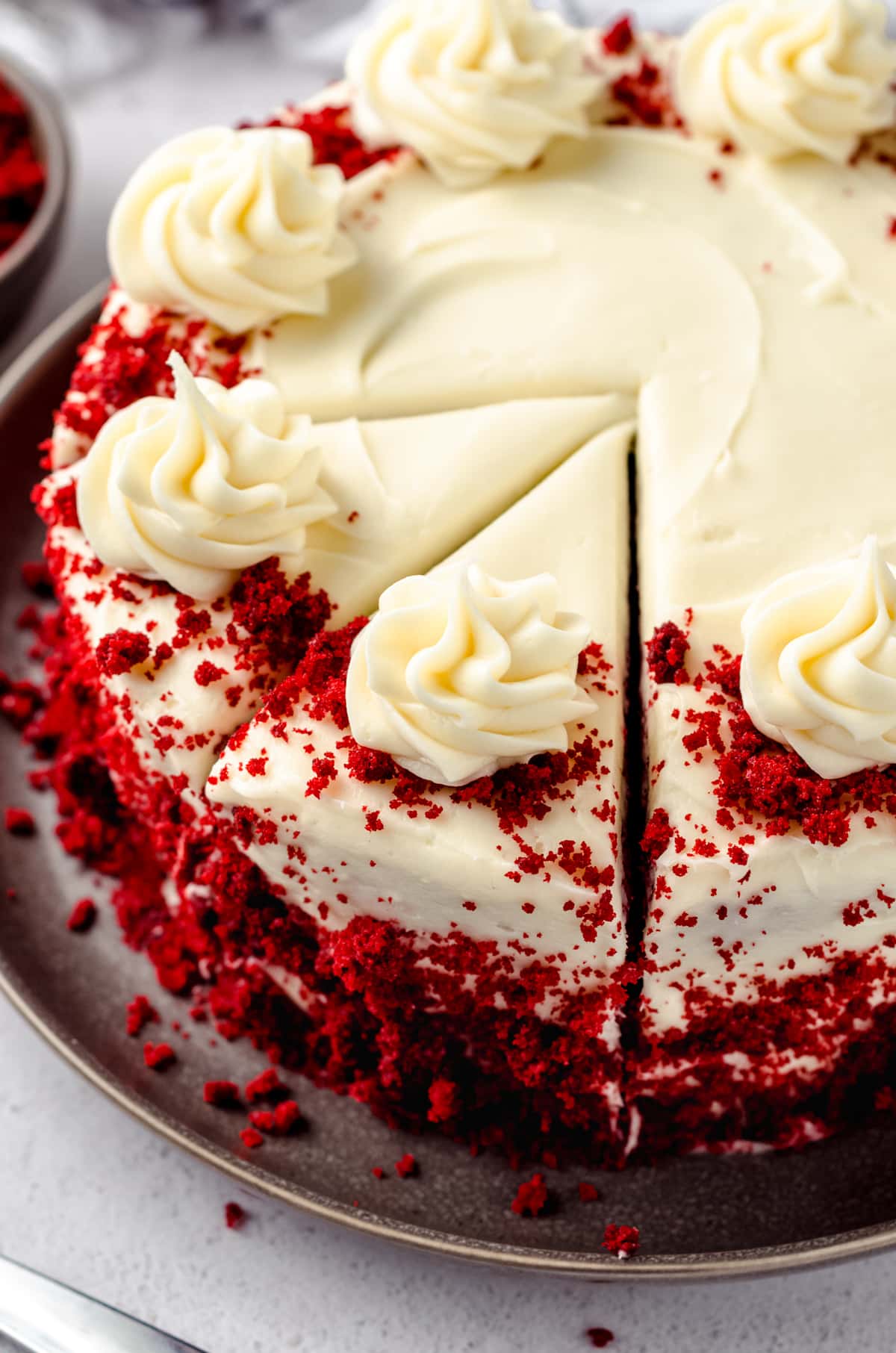
Before I shared recipes with home bakers like you on the internet, I spent nearly 4 years baking cakes for hire for birthdays, weddings, and showers, and I made this classic cake at least 30 times in those 4 years. If you prepare your ingredients and follow my favorite red velvet cake recipe exactly, I can guarantee you’ll be uttering “mmm” between bites of this iconic cake in no time.
HOMEMADE RED VELVET CAKE INGREDIENTS
There are a few key ingredients in red velvet cake, but for the most part, you likely have all of the ingredients necessary in your pantry already.
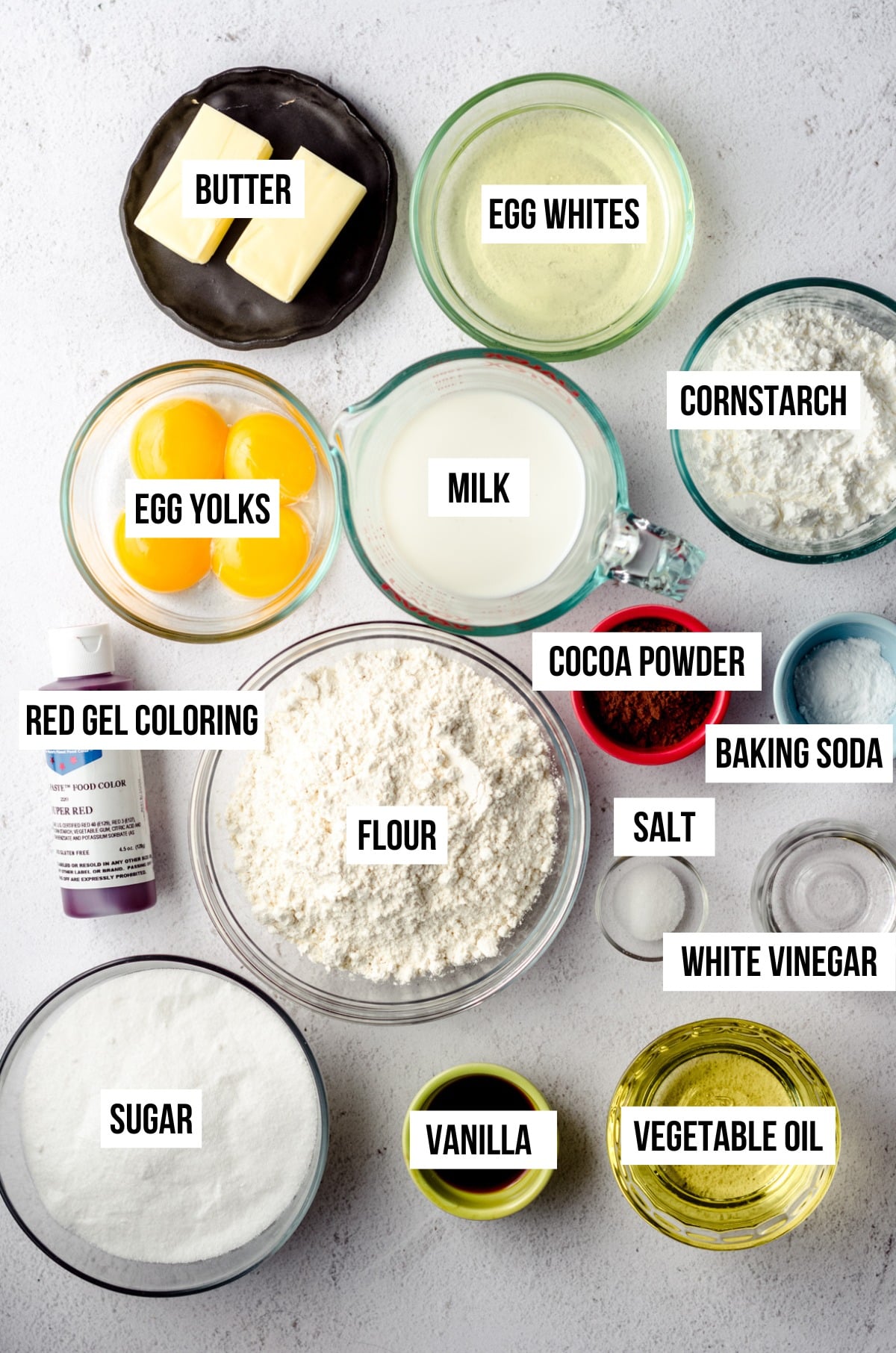
For this red velvet cake recipe, you will need:
ALL-PURPOSE FLOUR— a lot of fluffy cake recipes call for cake flour, which boasts lower protein than all-purpose. With a careful adjustment of the amount of all-purpose flour combined with the next ingredient on our list, we can replicate the fluffiness of using cake flour without actually using it.
CORNSTARCH— I use cornstarch often in my cookie recipes to keep them soft. As mentioned, when combined with all-purpose flour in a cake recipe, we can encourage a fluffy cake crumb.
UNSWEETENED COCOA POWDER— with only 3 Tablespoons in the whole cake, no, it does not qualify red velvet cake as a chocolate cake, per se. Since cocoa powder is considered an acidic ingredient, it reacts with the baking soda and buttermilk (or vinegar/lemon juice + milk) to create a tight, tender crumb.
SALT— just a bit, because no baked good should ever go without salt.
BAKING SODA— this is our key leavening agent. When combined with acidic ingredients like cocoa powder and buttermilk (or our substitute), it produces carbon dioxide which = lots of bubbles which = a cake that rises beautifully.
UNSALTED BUTTER— butter will bring, obviously, a buttery flavor to cake, as well as a source of fat. Believe it or not, when we cream butter and sugar together, we’re also contributing to the “fluff” factor in our cake as the fat traps air during creaming that releases in the oven while the cake bakes.
GRANULATED SUGAR— oddly enough, red velvet cake is not a super sweet cake. It’s actually quite tangy with the perfect amount of sweetness. I typically opt for brown sugar in cookies to bring maximum flavor and moisture, but in order to keep this cake fluffy, we have to choose a lighter (in mass) sugar. We’ll add extra moisture with the next ingredient.
OIL— I have experimented a lot with using all butter in my red velvet cake recipe, and I just can’t quite replicate the same moist cake crumb that I can when I use a combination of butter and oil. I like using avocado oil, but you can use vegetable or canola if you prefer.
EGGS— these will need to be at room temperature and separated. We’ll use the egg whites separately from the yolks to insure a fluffy crumb.
VANILLA EXTRACT— the garlic of the baking world. Never leave it out!
DISTILLED WHITE VINEGAR— I know, this is a strange ingredient to have in a cake recipe, but it is essential for aiding in leavening the cake. Back in the day, red velvet cake was actually colored with beet juice, which can turn blue when baked. The acid from the vinegar made a chemical reaction with the beet juice to keep it nice and red, and despite modern ingredients and methods, distilled vinegar has stuck around in the list of common ingredients in red velvet cake.
BUTTERMILK (or VINEGAR/LEMON JUICE + MILK)— believe it or not, even as a regular baker (I do this 2-4 times a week!), I rarely, if ever, have buttermilk on hand. But, buttermilk is crucial to the success of red velvet cake. The good news is, you can make homemade buttermilk easily with distilled white vinegar or lemon juice and regular milk, which is what I do 99% of the time. See the notes in the recipe for adjusting the amount of distilled white vinegar in this recipe if you do have buttermilk.
RED FOOD COLORING— I prefer to use gel food coloring, but liquid food coloring will work just fine. See recipe notes for my favorite brand.
BEST FROSTING FOR RED VELVET CAKE
We’ll top this homemade red velvet cake with my favorite tangy cream cheese frosting. It’s my go-to for everything from cake to homemade cinnamon rolls, and it’s the perfect pair for the slightly tangy flavor of the velvety crumb.

For the cream cheese frosting, you will need:
• full fat block cream cheese
• room temperature butter
• powdered sugar
• vanilla extract
•salt
Best Red Velvet Cake Recipe Tips
It’s not always that I spend a lot of time drilling notes into your head before you start baking, but when it comes to this classic cake recipe, it’s important to prepare your ingredients and follow the steps exactly.

ROOM TEMPERATURE INGREDIENTS
This preparation step is so important that I dedicated an entire post to it.
Your butter, milk/buttermilk, and eggs must be at room temperature. It’s important your butter especially is at room temperature and not warmer. Room temperature butter is cooler than you likely think it is, so be sure it’s not too soft, otherwise your red velvet cake is sure to be dry.
It’s important to be sure your cream cheese frosting ingredients are also at room temperature so our frosting stays nice and smooth and free from lumps.
WORK SLOWLY
In a bit, you will be whipping egg whites to fold into your red velvet cake batter. It will be crucial to fold this in slowly and gently in order to keep all of the air in the egg whites which will help leaven the cake and keep it fluffy.
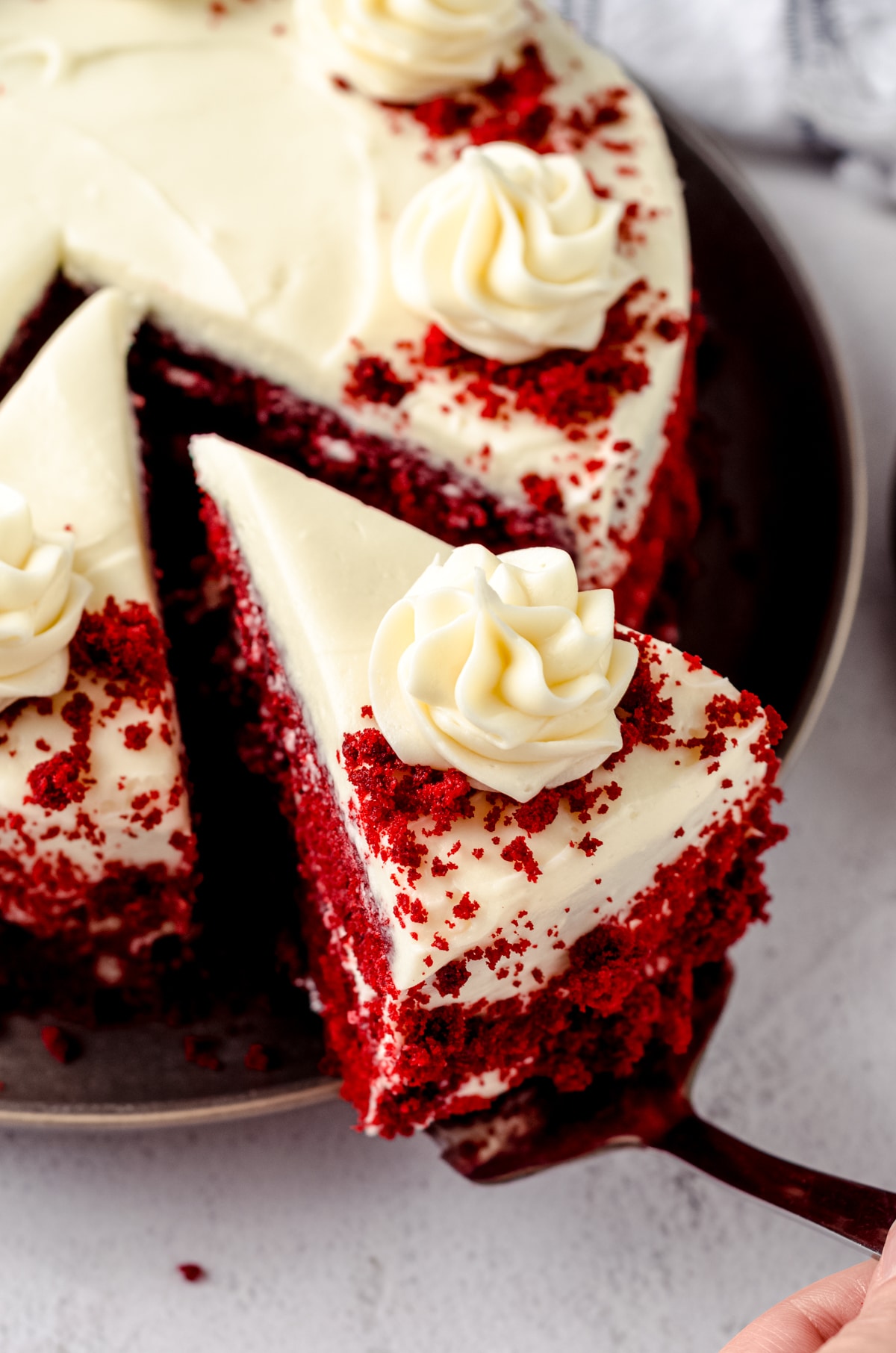
This is not a recipe where we can just dump all of the ingredients together and expect a perfect crumb. As I mentioned, red velvet cake can be finicky, so take care in every step.
READ THE RECIPE FIRST
This step should be done no matter if you’re a beginner baker or a pro. Know what to expect and read the notes so you’re not surprised at what comes next.
Now, let’s get started.
How to Make Red Velvet Cake from Scratch
While the instructions are laid out in the recipe card, I have plenty of pictures in this post so you can know exactly what what you’re looking for while tackling this cake recipe.
STEP 1: SIFT THE DRY INGREDIENTS
Before doing anything else, you’ll be sifting you dry ingredients together. Do not skip this step. Sifting removes lumps, combines your dry ingredients in a uniform fashion, and sets you up for a seamless entry of dry ingredients into your wet ingredients.
STEP 2: SOUR THE MILK
As mentioned, I wrote this recipe assuming you do not have buttermilk. So at this point in the recipe, add 1 Tablespoon of the distilled white vinegar to the milk, stir it around, and let it sour while you proceed with the recipe. You’ll use the remaining 2 teaspoons later with the wet ingredients.
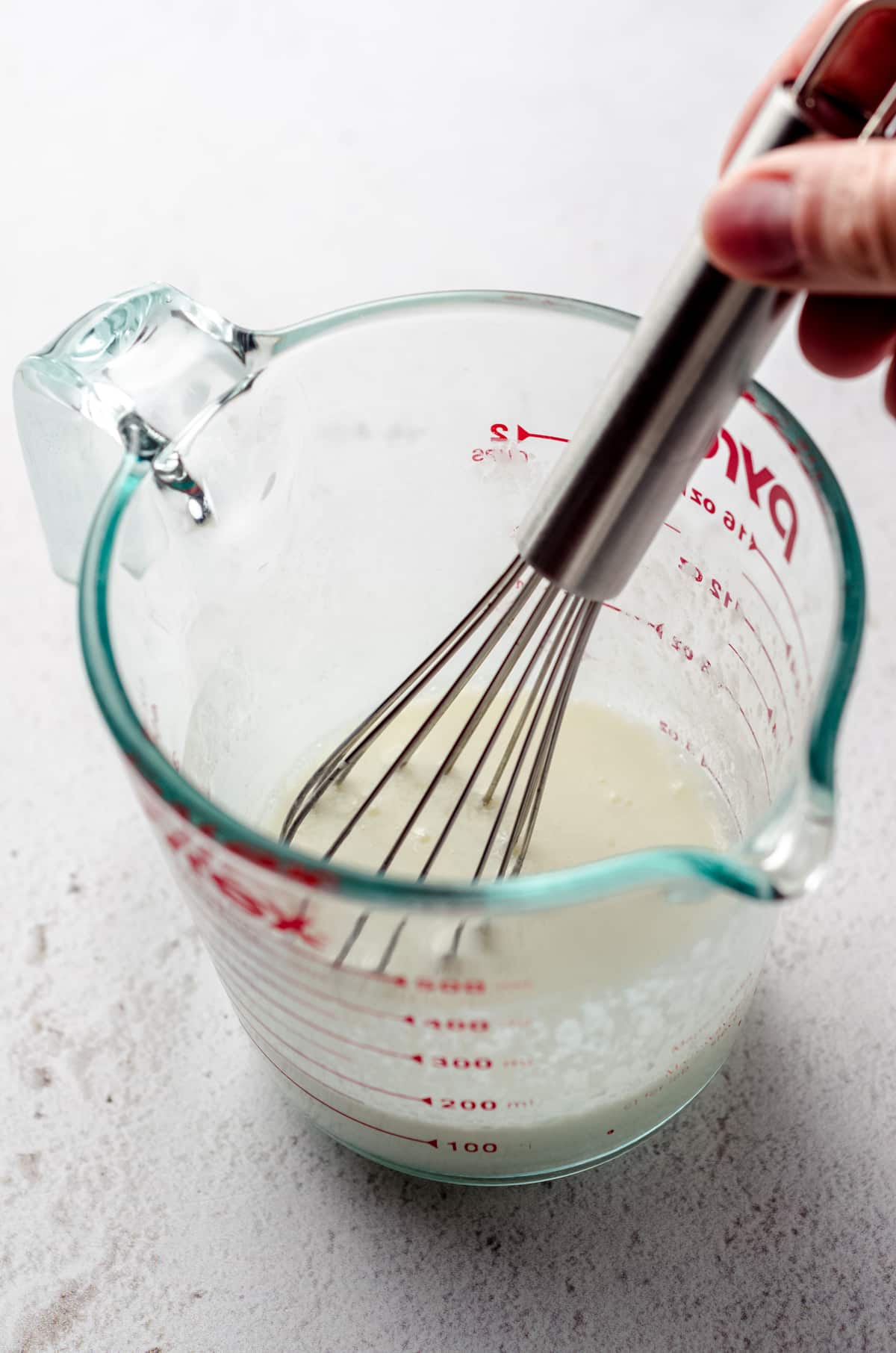
If you have buttermilk, you can skip this step. Be sure you’re using the adjusted amount of additional distilled vinegar in the recipe, as you will still need it, just not as much.
STEP 3: MAKE THE FAT BASE
To kick your cake off on the right fluffy foot, cream the butter and sugar until it is light in color and fluffy in texture, then beat in the vegetable oil and the egg yolks. Remember, room temperature eggs are crucial to keeping the butter at room temperature so that our end result is moist and buttery, not dry and dense.
You’ll also be adding your vanilla and red food coloring to this base before moving on to incorporating the dry ingredients.
STEP 4: ALTERNATE THE DRY INGREDIENTS WITH THE SOURED MILK
Guess what? Another crucial step.
You’ll split your dry ingredients into roughly 3 parts (just eyeball this, it doesn’t have to be perfect) and your buttermilk/vinegar or lemon juice + milk in half (again, eyeball), then, starting with the dry ingredients, alternate adding each to the batter and letting it slowly incorporate.
WHY ARE WE ALTERNATING INGREDIENTS?
Rather than adding everything all at once, we want to keep the integrity of the cake batter without overloading it with too many dry ingredients to find places for nor do we want to overload it with liquid.
By adding a bit of the dry ingredients first, we give the liquid somewhere to go and absorb into, so as to keep the batter nice and smooth and avoid flooding it or creating lumps.
This is a step I use in delicate cake batters that seems silly but really does yield flawless results.
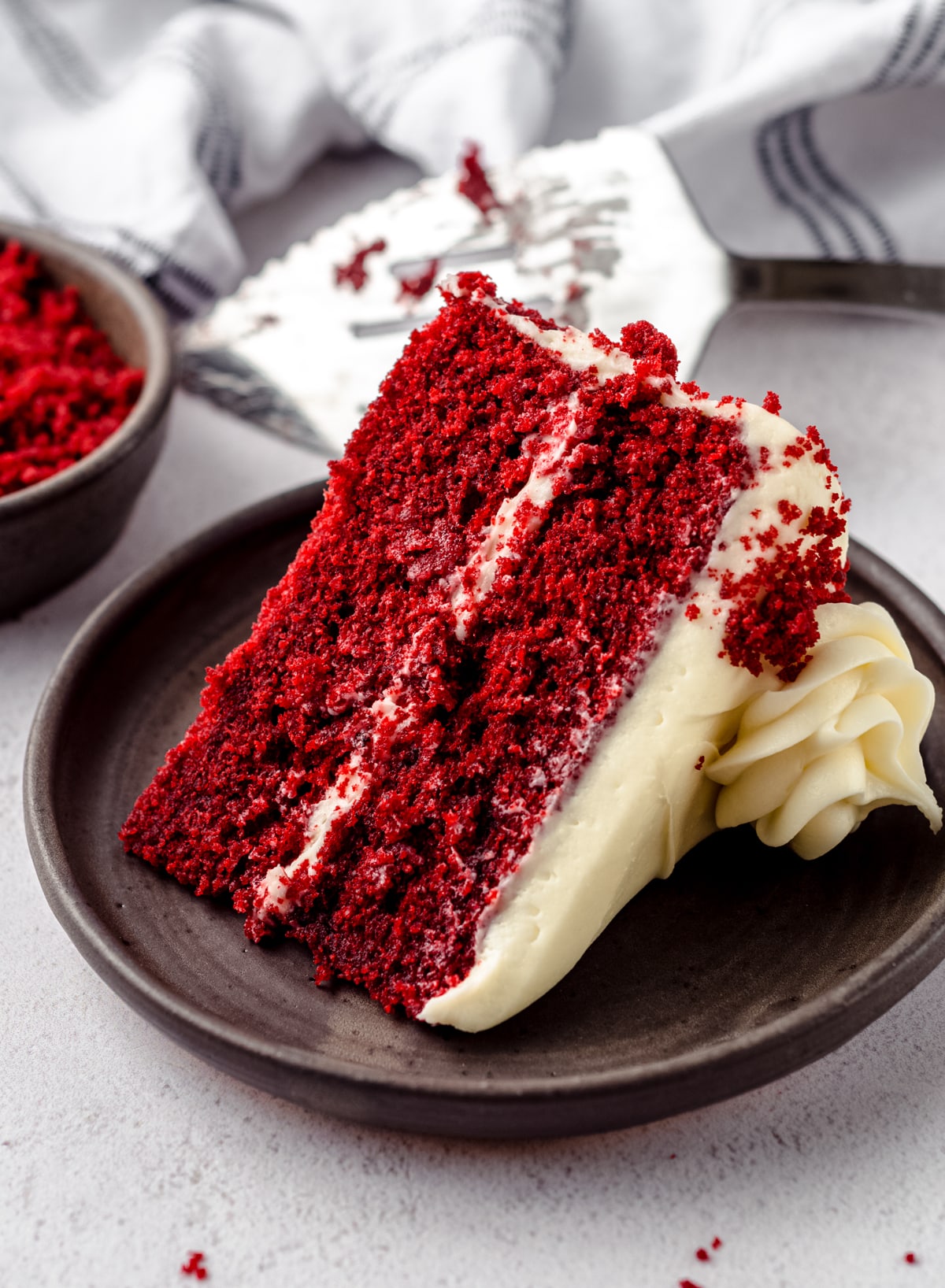
Again, don’t worry about splitting these into perfect proportions. Trust your eyeballs to guide you.
Once you’ve added the final portion of dry ingredients, stop blending when they have mostly incorporated. The batter may not look totally combined, but that’s ok. Our next step will take care of it.
STEP 5: WHIP THE EGG WHITES
Whip the egg whites to soft peaks, which means when you pull the whisk or beaters out of the egg whites, you will see little peaks left behind that flop over on the tips.
If there are no peaks at all, it’s not quite there. If the peaks are stiffer, you’ve gone a little too far, but this is ok. Just don’t whip it any more.
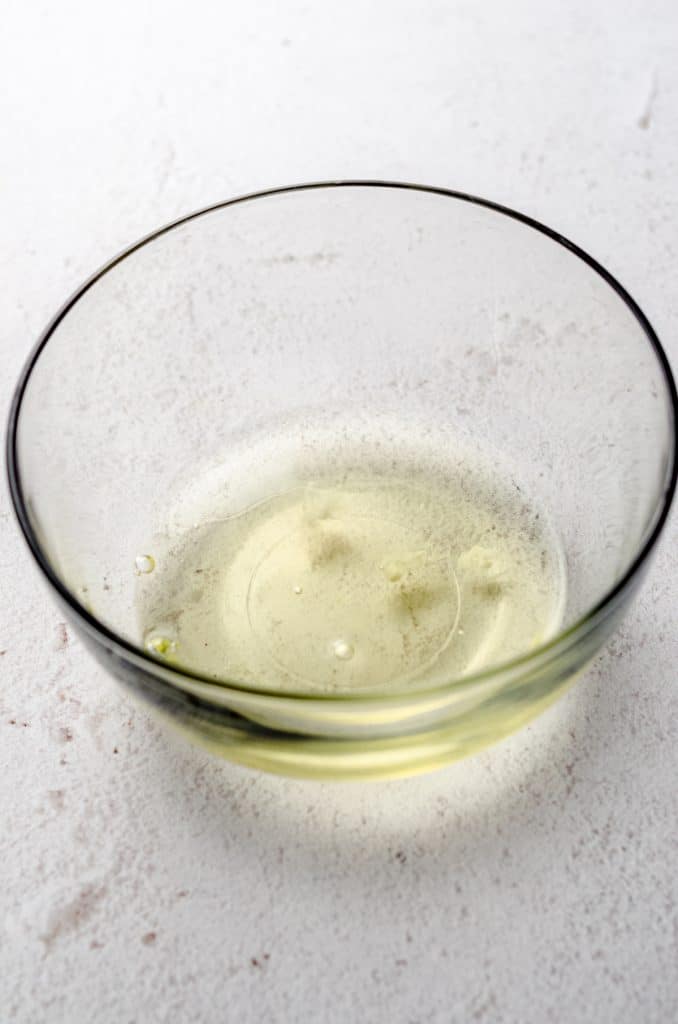
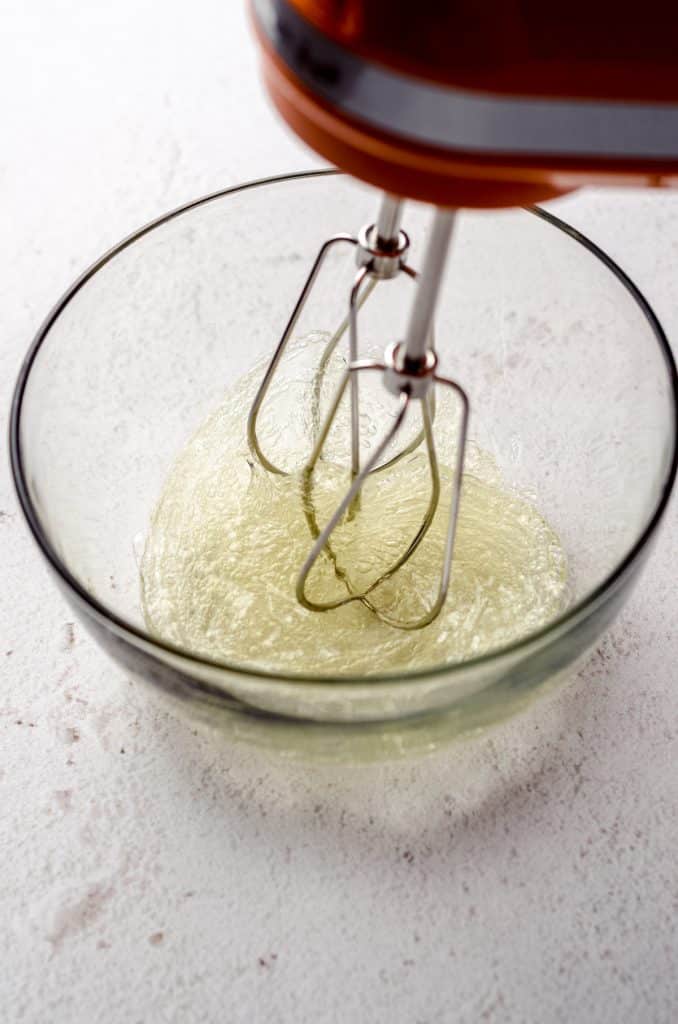
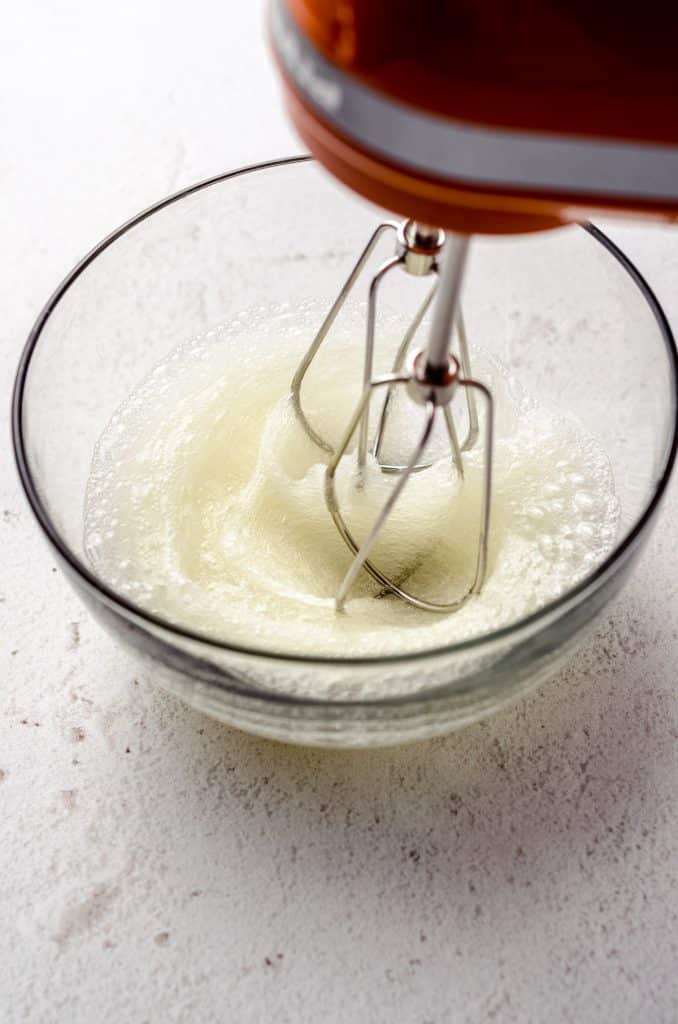

If you’re using an electric hand mixer, just rinse off your beaters and whip the egg whites in a separate bowl. If you used a stand mixer, your bowl may be occupied with cake batter. That’s ok!
You can either use an electric hand mixer, if you have one available, another bowl for your stand mixer + the whisk attachment, or use some good old elbow grease and a whisk to whip the egg whites by hand.
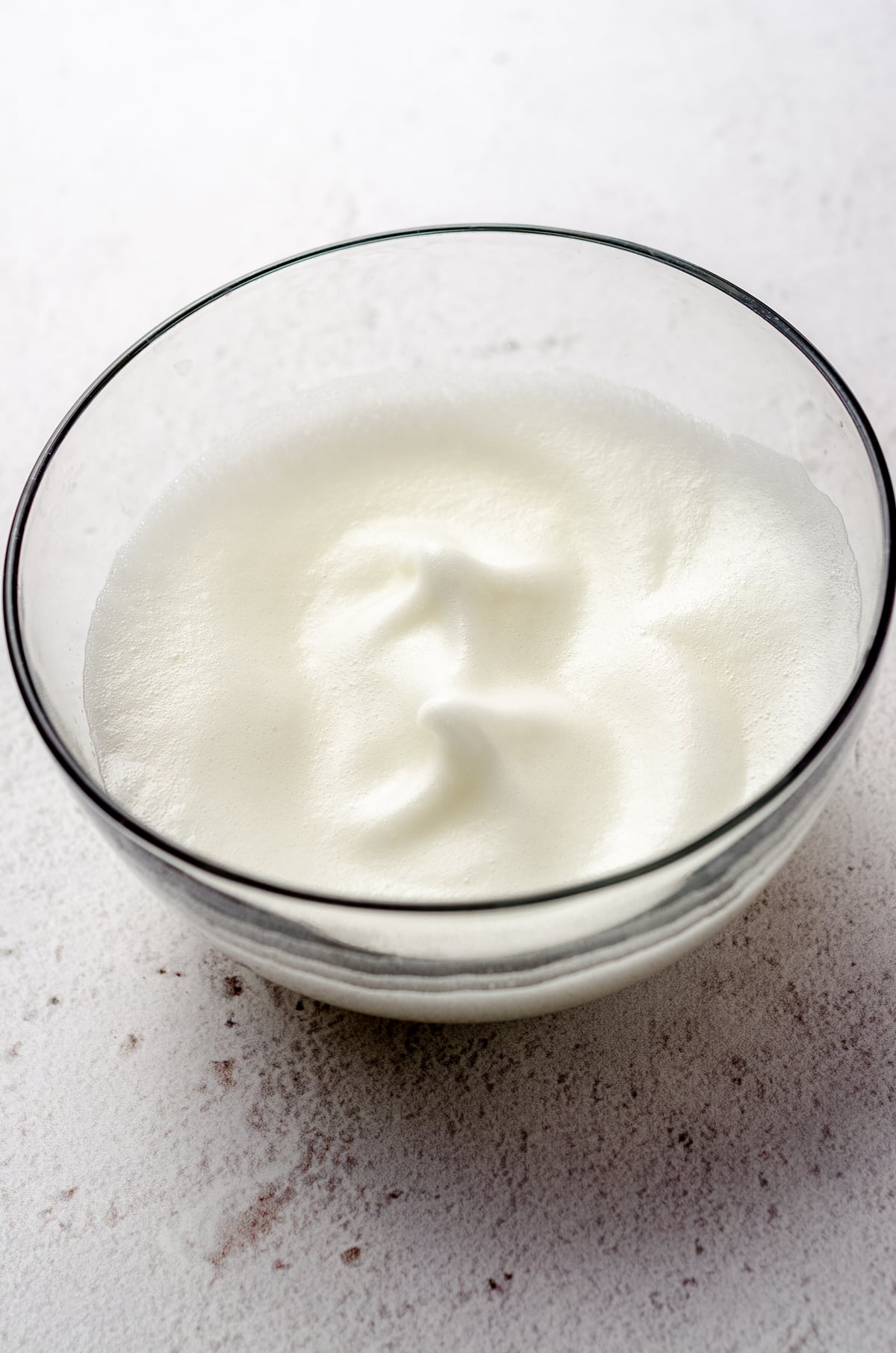
It will only take about 3 minutes or so. Remember to look for those soft peaks like the picture above.
STEP 6: FOLD IN THE EGG WHITES
Lastly, we’ll fold the egg whites in gently, which will be our final source of air for fluffiness.
To fold in the egg whites, pour them all into the batter, then use your spatula to cut a line down the middle of the batter, then gently scoop up half of the batter and fold it onto the other half. Turn the bowl a quarter turn, then repeat.
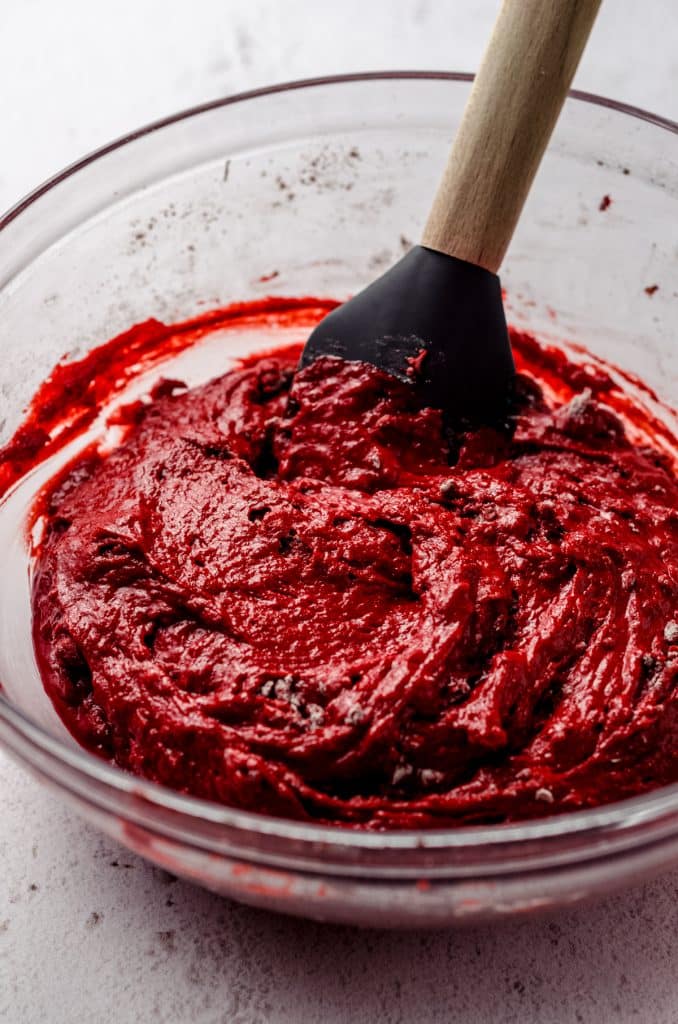
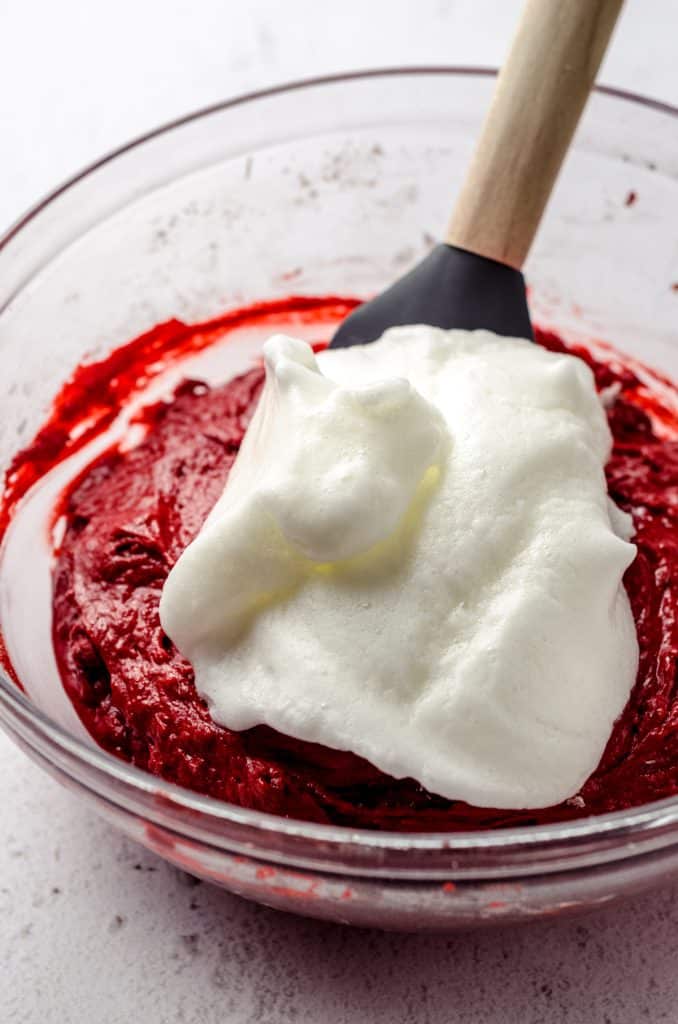
This method of folding will insure your egg whites are kept nice and airy and will decrease the chances of deflating, which we could easily do by vigorously adding the egg whites while the mixer is moving or aggressively stirring them in.
As the egg whites incorporate, so will the straggling dry ingredients.


You’ll know your cake batter is ready to bake when it’s silky smooth and slightly thick.
STEP 7: POUR INTO PREPARED PANS
You can bake this red velvet cake in three-6″ pans, or two 8″ or 9″ pans. See recipe notes for bake times.
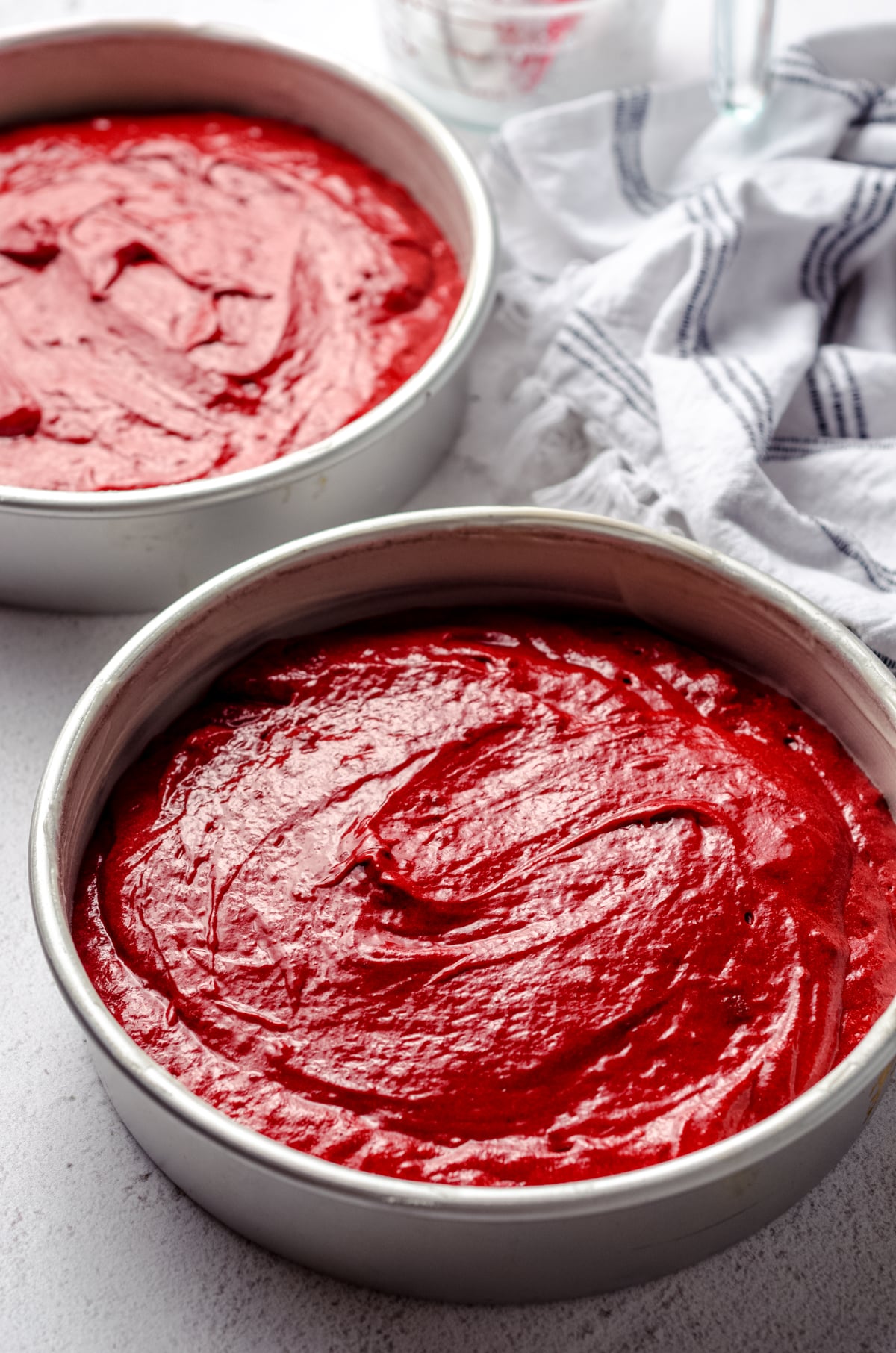
It’s very important not to overbake red velvet cake. I told you it was finicky, didn’t I?
STEP 8: DO NOT OVERBAKE RED VELVET CAKE LAYERS
Total bake time for 8″ round pans (what I typically use) is about 38 minutes, and I will sit and babysit my cake for those last 5-8 minutes to insure I pull it out just at the right time.
You want to look for moist crumbs on your cake tester but not wet batter. Do not wait for a totally clean/dry tester, as the cake layers will continue to bake in the pans when you take them out of the oven.
Allow the cake layers to cool in the pans on a cooling rack before removing from the pans to assemble and decorate.
STEP 9: MAKE THE CREAM CHEESE FROSTING
When you are ready to frost the cakes, make the cream cheese frosting. You can make this up to a day in advance if you’d prefer to finish your cake the next day or want to work ahead.
First, beat the butter and cream cheese until nice and smooth. Turn the mixer speed down to low and add the powdered sugar.
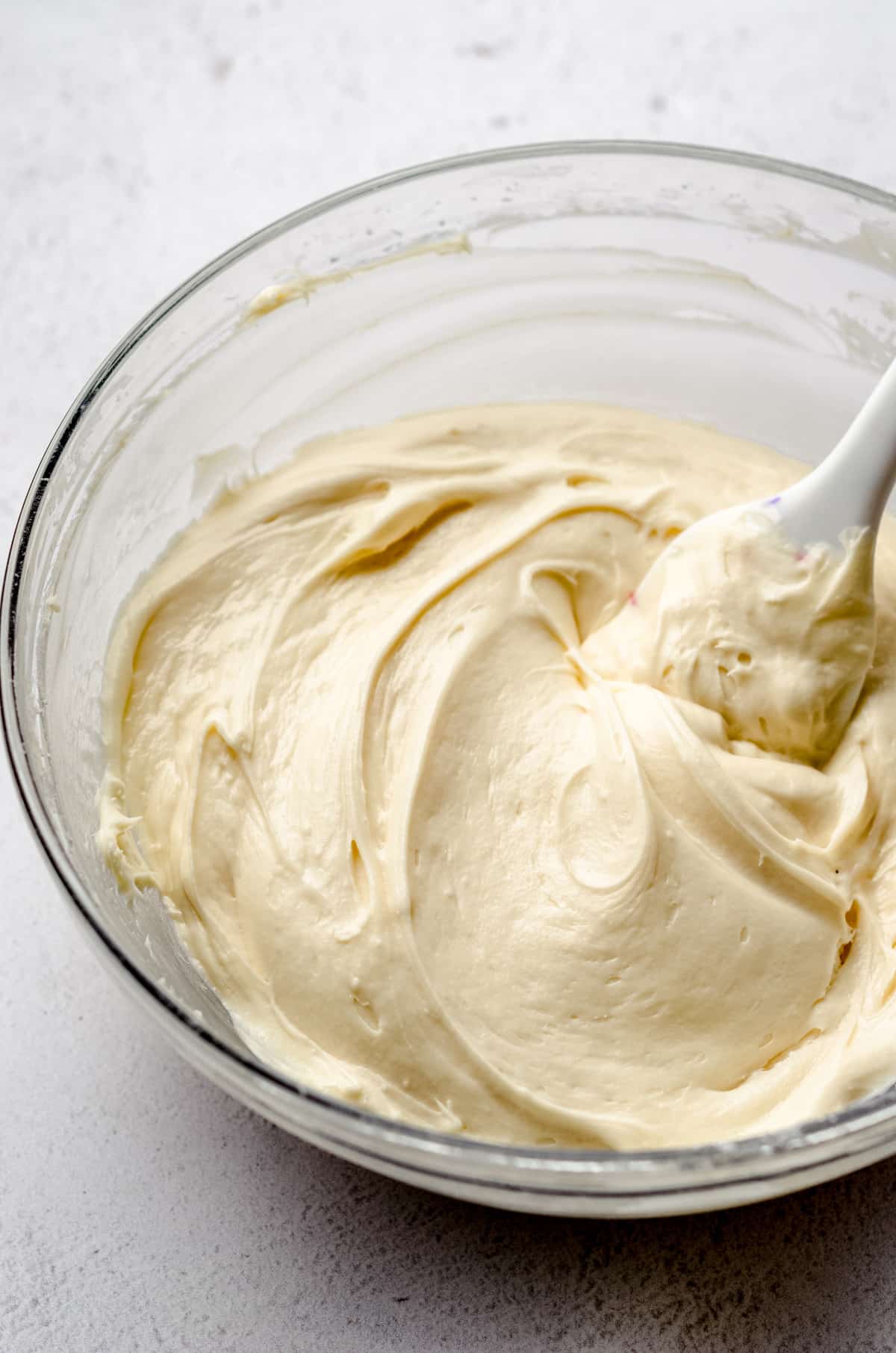
Lastly, add the salt and continue mixing until smooth.
STEP 10: ASSEMBLE THE HOMEMADE RED VELVET CAKE
Here is where you can get fancy or keep things simple.
If you want more than two layers in your cake, you can split each cake layer in half to create four luxurious layers, or you can stick to the two you baked.
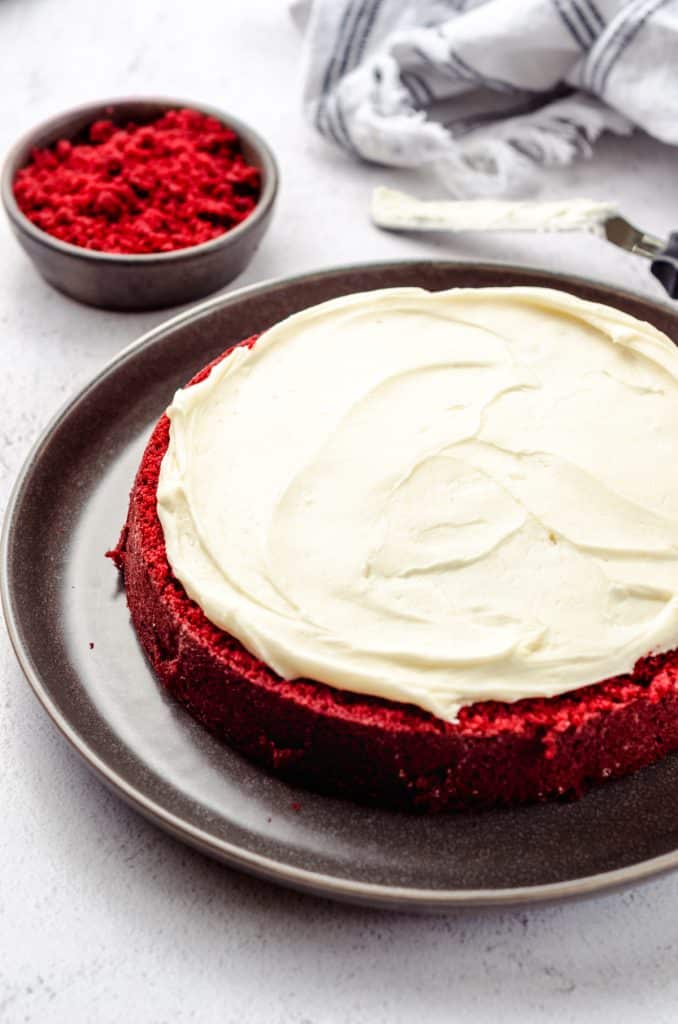
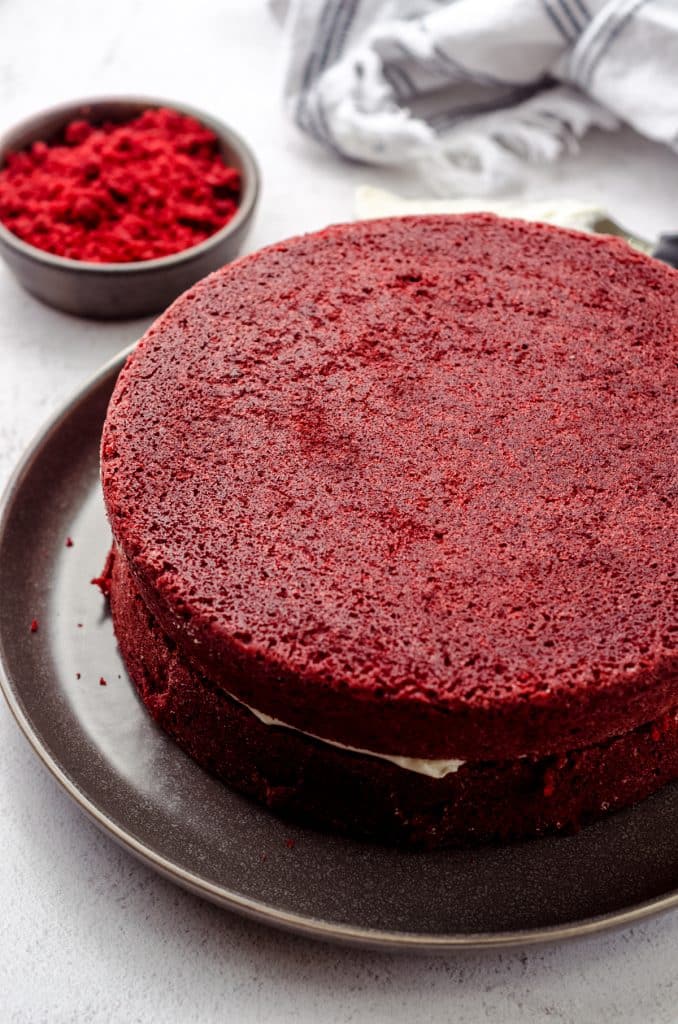
Level the cakes with a serrated knife or a cake leveler (my favorite is linked in the recipe), then stack and frost.
Best Red Velvet Cake Decoration
Red velvet cakes are often decorated very simply, as the inside is so show-stopping, we don’t need a whole lot of fancy happening on the outside.
Traditionally, red velvet cakes are garnished with cake crumbs, but you’re welcome to embellish the cake as much or as little as you wish.
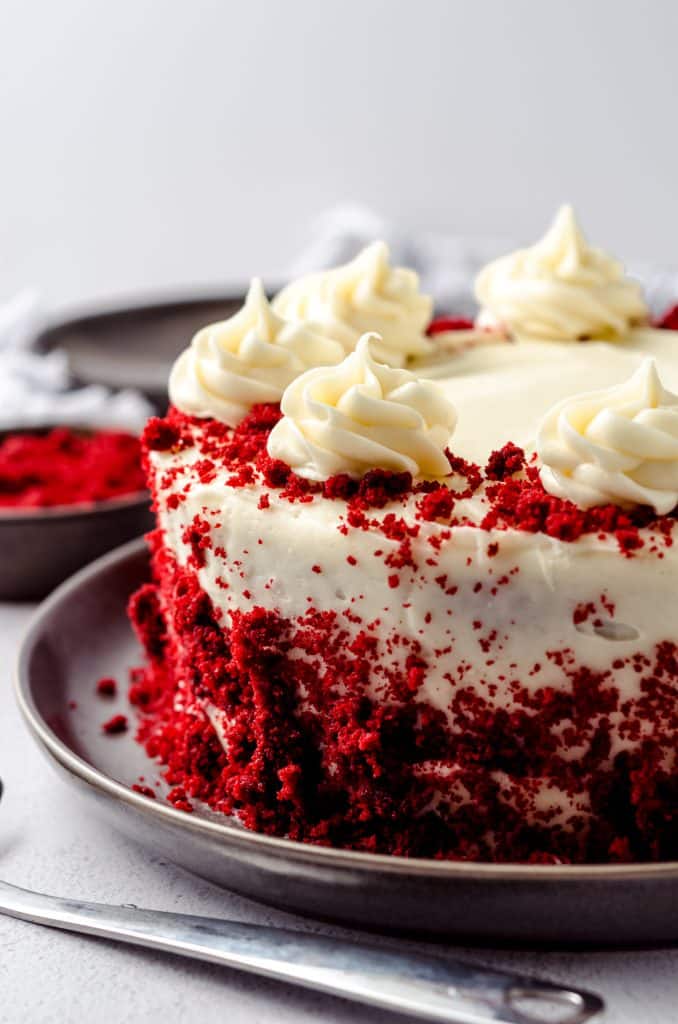
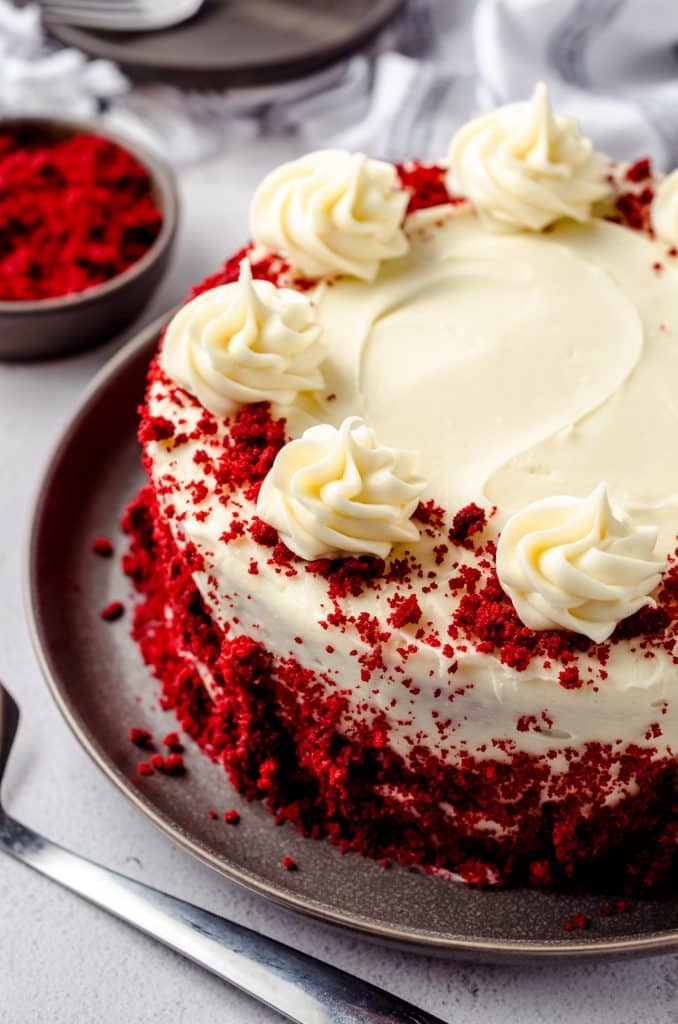
You are presenting this perfect cake, after all. Because you did it. You created the perfect red velvet cake. You know how I know? Because you read every step and followed the instructions to a T.
Pat yourself on the back. It can feel intimidating to get this cake just right, but with careful attention and confidence, you, too, can feel like (and actually be!) an expert red velvet cake baker.
FAQs for this Red Velvet Cake Recipe from Scratch

Now that you have mastered my easy red velvet cake recipe, you’re ready for more red velvet treats! Try any of these red velvet (from scratch) recipes next: red velvet cupcakes, red velvet cookies with cream cheese frosting, red velvet bundt cake, red velvet brownies, red velvet crinkle cookies, and red velvet sheet cake.
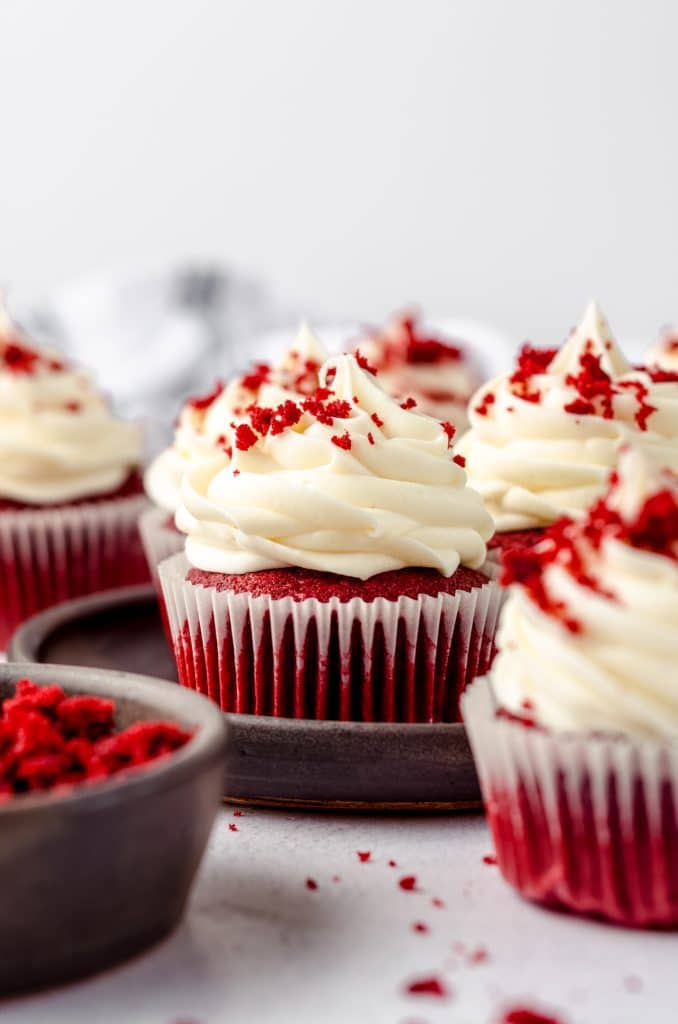
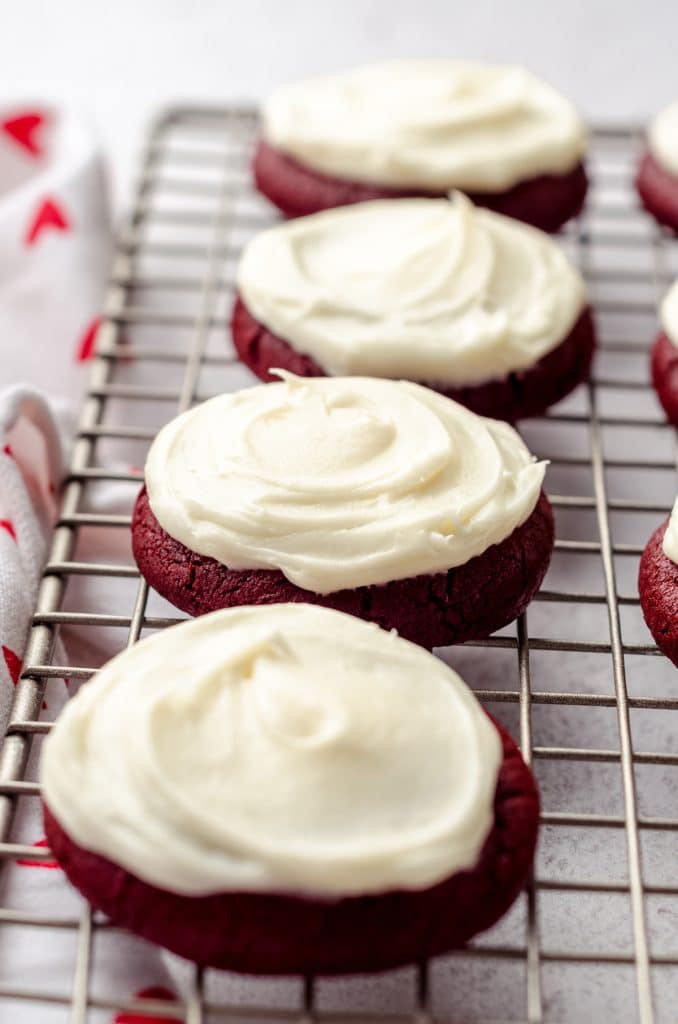
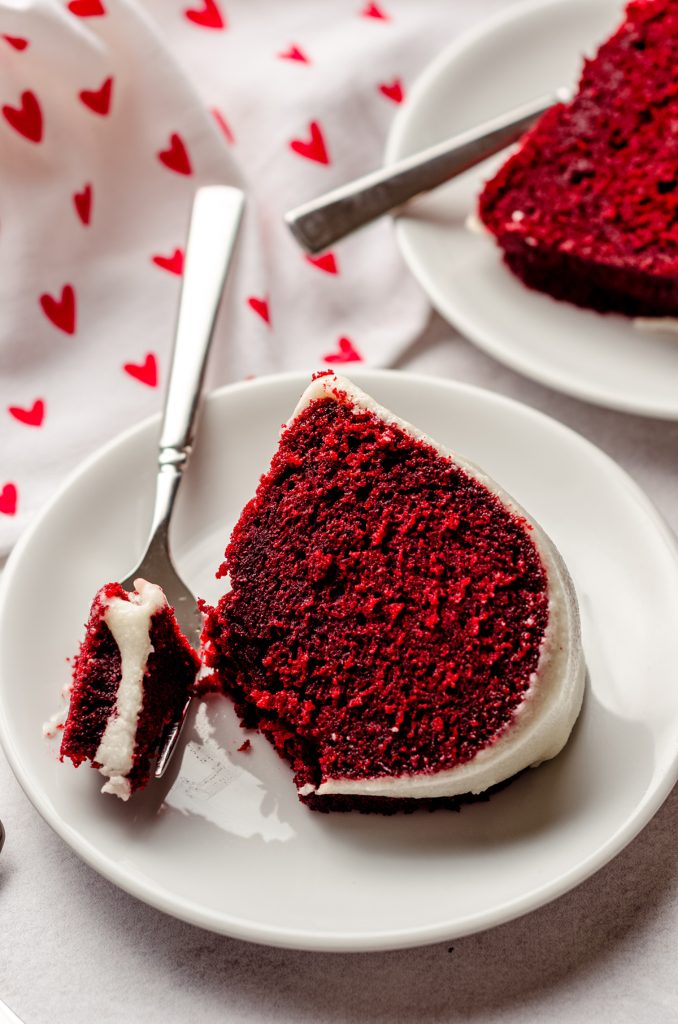

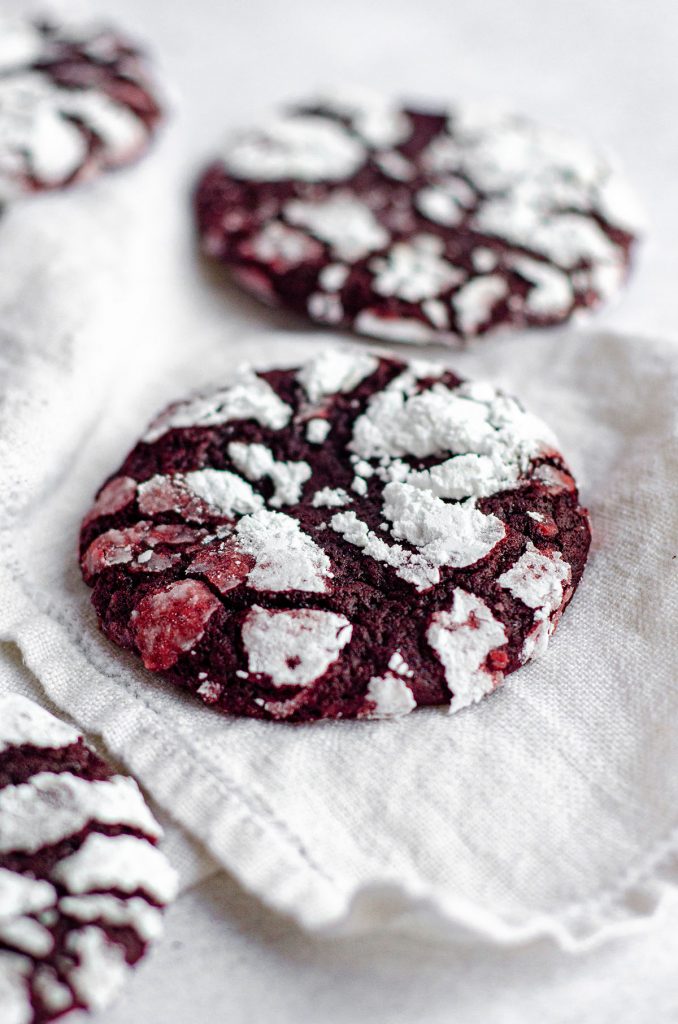
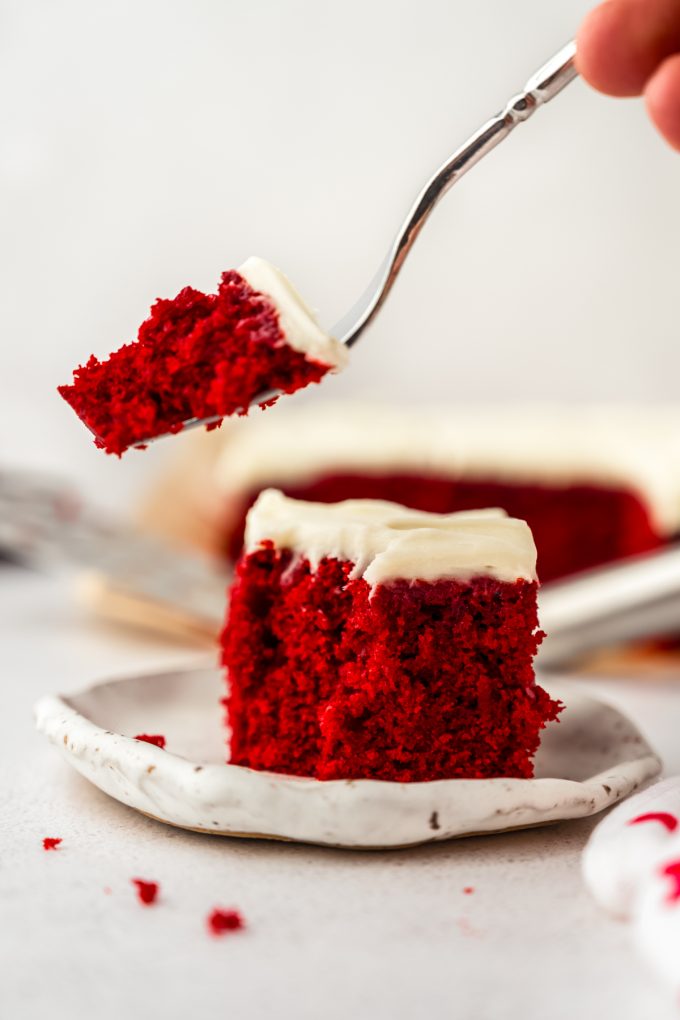
Best Red Velvet Cake from Scratch
Ingredients
RED VELVET CAKE
- 2 and ½ cups (300g) all-purpose flour be sure to measure properly
- ½ cup (80g) cornstarch
- 3 Tablespoons (18g) unsweetened cocoa powder
- 1 teaspoon salt
- 1 teaspoon baking soda
- ½ cup (113g) unsalted butter softened to room temperature
- 2 cups (400g) granulated sugar
- ⅔ cup (160mL) vegetable oil
- 4 large eggs room temperature and separated
- 1 Tablespoon vanilla extract
- 1 Tablespoon + 2 teaspoons distilled white vinegar1
- 2 teaspoons red food coloring2
- 1 cup (240mL) milk1 room temperature; you can also use buttermilk (see notes)
CREAM CHEESE FROSTING
- 8 ounces (225g) full fat block cream cheese softened to room temperature
- ½ cup (113g) unsalted butter softened to room temperature
- 3 and ½ cups (420g) powdered sugar
- 2 teaspoons vanilla extract
- ⅛ teaspoon salt
Instructions
RED VELVET CAKE
- Move a rack in the oven to the middle position and preheat it to 350ºF (177ºC). Grease and flour (or use homemade cake release) two 8" round cake pans3 and set aside.
- Sift the flour, cornstarch, cocoa powder, salt, and baking soda together into a medium size bowl. Set aside.2 and ½ cups (300g) all-purpose flour, ½ cup (80g) cornstarch, 3 Tablespoons (18g) unsweetened cocoa powder, 1 teaspoon salt, 1 teaspoon baking soda
- If you are using regular milk: add 1 Tablespoon of the distilled white vinegar to the milk and stir it around. Reserve the remaining 2 teaspoons of vinegar for the next step. If you are using buttermilk: skip this step and add the additional 2 teaspoons of vinegar in the next step.
- In a large bowl with a handheld mixer or the bowl of a stand mixer fitted with the paddle attachment, cream the butter and sugar together on medium speed until light and fluffy (approximately 2-3 minutes). Add the vegetable oil and beat again until completely incorporated. Add the egg yolks, vanilla extract, remaining vinegar, and food coloring and beat again on medium speed until everything is combined.½ cup (113g) unsalted butter, 2 cups (400g) granulated sugar, ⅔ cup (160mL) vegetable oil, 4 large eggs, 1 Tablespoon vanilla extract, 1 Tablespoon + 2 teaspoons distilled white vinegar1, 2 teaspoons red food coloring2
- Turn the mixer down to low speed and add the dry ingredients in three additions, alternating with half of the milk/buttermilk. Do not overmix batter, and stop after the last bit of dry ingredients is mostly incorporated. There may be some dry pockets remaining. This is ok.1 cup (240mL) milk1
- Whip the egg whites in a medium size bowl, either using a handheld mixer or a whisk, whisking vigorously by hand. Whip the egg whites until soft peaks form (see the photo in the post above if you're unsure what this looks like). This will take about 2-3 minutes.
- Gently fold the whipped egg whites into the batter with a spatula by cutting your spatula down the middle of the batter, then gently scooping half of the batter over and on top of the other half of the batter. Turn the bowl ¼ of a turn and repeat until batter is silky and smooth. It will be slightly thick.
- Divide batter evenly between the two (or three) prepared cake pans. Bake cakes for 32-38 minutes or until a toothpick or cake tester inserted in the center comes out mostly clean. If the cakes need a little longer, indicated by wet batter on the toothpick, bake for a minute longer and retesting, taking care not to overbake the cakes as they will dry out. You may need to bake an additional minute, test, and rebake and retest until it is properly finished. Remove cakes from oven and allow to cool in the pans completely on a wire rack before removing and assembling.
CREAM CHEESE FROSTING
- In a large bowl with a handheld mixer or the bowl of a stand mixer fitted with a paddle attachment, beat the cream cheese and butter on medium-high speed until smooth.8 ounces (225g) full fat block cream cheese, ½ cup (113g) unsalted butter
- Turn the mixer speed down to low and slowly add the powdered sugar. Add the vanilla extract and salt and continue mixing until smooth.3 and ½ cups (420g) powdered sugar, 2 teaspoons vanilla extract, ⅛ teaspoon salt
DECORATE THE CAKE
- For a 2 layer cake: place one layer, bottom side up, on a plate or cake stand. Using a spatula or knife, spread an even layer of colored frosting over the entire surface. Place the second layer on top, bottom side up, and press down on the top lightly. Spread the rest of the cream cheese frosting on the cake, beginning with the top and working your way down the sides. Decorate as desired.
- For a 4 layer cake: split each layer into two smaller layers using a cake leveler or serrated knife and repeat steps for 2 layer cake.
- Cake stays fresh covered at room temperature for up to 4 days. Cake may be covered and refrigerated for up to 7 days.
- Make ahead: prepare cakes and frosting up to 1 day in advance. Cover cakes tightly and keep at room temperature or in the refrigerator until ready to assemble. Refrigerate prepared frosting in an airtight container until ready to use. Unfrosted cake layers may be frozen, wrapped tightly, up to 2 months. Thaw overnight in the refrigerator before assembling. Frosted cake can be frozen, wrapped tightly, up to 2 months. Thaw overnight in the refrigerator and bring to room temperature before serving.
Notes
- Distilled white vinegar/milk: I rarely have buttermilk on hand, so I always make my own. As written, the recipe assumes you do not have buttermilk. If you do have or prefer to use buttermilk, reduce the total amount of distilled vinegar in the recipe to 2 teaspoons, add it to the cake batter alongside the vanilla extract, and use 1 cup of room temperature buttermilk.
- Red food coloring: I prefer gel food coloring, as it is more concentrated than liquid food coloring. If you only have liquid food coloring, increase to 1 Tablespoon (15mL).
- Cake pans: this recipe will fit also fit in two-9″ round cake pans (reduce bake time to 28-34 minutes) or three-6″ round cake pans (reduce bake time to 18-24 minutes).
Nutrition Disclosure
All nutritional values are approximate and provided to the reader as a courtesy. Changing ingredients and/or quantities will alter the estimated nutritional calculations.

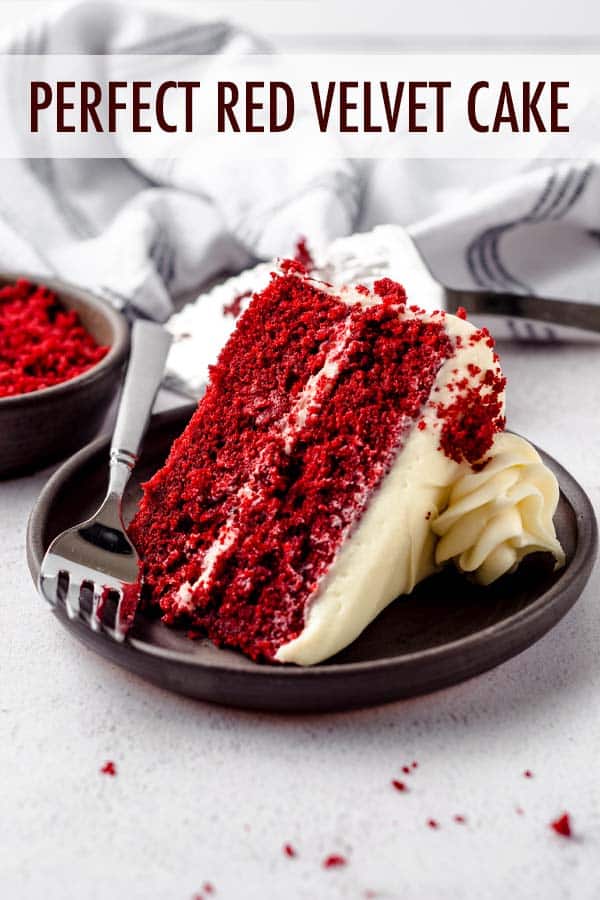

This cake was a huge hit!! Made it for a galentines celebration and it was devoured in no time. Super easy to make and it was so moist!
Thank you so much, Grace!
Okay, not only was I enticed by your gorgeous photos of this cake, but loved all your tips! Mine is cooling right now, and will be the PERFECT way to celebrate our day tomorrow!
Thanks, Kathleen! 🙂
This red velvet cake is perfection! The chocolately cake is the MOST gorgeous color, and it pairs so beautifully with the sweet tangy vanilla cream cheese frosting. Love your recipes!
Thank you, Eliza 🙂
What a stunning cake! The perfect texture! We just sliced it for Valentine’s Dinner and it is amazing!
Thank you! We love this cake here!
Thank you! 🙂
Thanks so much, Sheila!
I made this cake for a co-worker’s baby shower, and it turned out great! I think whipping the egg whites and folding them into the batter was a great technique to include in the recipe; it made the cake so fluffy and light!
I had to attend to a minor emergency situation while the cakes were in the oven, so I did end up pulling them out a couple minutes later than intended. Despite this mishap, the cake still turned out very moist and delicious regardless, and the icing was perfect as well.
Thanks so much for the great recipe, Lynn!
Thank you so much, Sarah! I’m so glad the cakes still made it out ok and hopefully that emergency was resolved ok, too! xoxo
One word…PERFECT! My children and I baked this for my husband’s birthday. Red Velvet cake is his absolute FAVORITE! Thank you for sharing. This cake is absolutely yummy!
Thank you so much, Erin!
I only have 9 inch cake pans? How do I change baking times, etc. to accommodate this?
Hi, Kathleen– I’m glad you found you answer 🙂